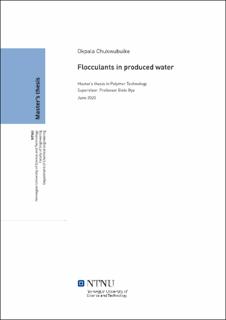| dc.contributor.advisor | Øye, Gisle. | |
| dc.contributor.advisor | Dudek, Marcin. | |
| dc.contributor.author | Okpala, Chukwubuike. | |
| dc.date.accessioned | 2021-09-28T18:22:41Z | |
| dc.date.available | 2021-09-28T18:22:41Z | |
| dc.date.issued | 2020 | |
| dc.identifier | no.ntnu:inspera:57621272:47107725 | |
| dc.identifier.uri | https://hdl.handle.net/11250/2785358 | |
| dc.description.abstract | Produsert vann som det viktigste biproduktet av leting etter olje og gass inneholder høye
mengder olje som ikke er trygt for avhending i vannmiljøet. Med det økende behovet for
olje og gass over hele kloden, er et av de største problemene som oppstår å utvikle
effektive tiltak for å behandle og oppfylle forskriften for gjenbruk eller avhending av
produsert vann riktig. Flokkulering er en essensiell prosess i behandlingen av produsert
vann og innebærer tilsetning av flokkuleringsmidler under behandlinger for å forbedre
effektiv separasjon av oljedråper fra vann. Flokkulering er imidlertid påvirket av pH og
saltholdighet, og dette arbeidet studerte effekten av disse faktorene på aggregering av
flokkuleringsmidler i vann.
Ulike konsentrasjoner av fire flokkuleringsmidler av Polydialldimetylammoniumklorid
(PolyDADMAC) F100k, F200k, F350k og F500k med forskjellige molekylvekter ble
fremstilt i varierende pH og saltkonsentrasjoner og testet. Flokkstørrelsesfordelingen,
Polydispersity Index (PDI) og Zeta potensial (ZP) ble karakterisert med en zeta-størrelse.
Adsorpsjon til silikondioksidoverflater ved bruk av Quartz Crystal Microbalance with
Dissipation (QCM-D) ble også bestemt. Det ble funnet at fordelingen av
flokkulasjonsstørrelsen, PDI og ZP varierte fra en flokkuleringsmiddel til en annen ved
forskjellige konsentrasjoner som viser at valget av flokkuleringsmidler spesifikt avhenger
av vannets pH og saltholdighet. Mer masse ble adsorbert ved høyere saltinnhold og pHverdier og var også avhengig av typen og konsentrasjonen av flokkuleringsmiddelet. | |
| dc.description.abstract | Produced water as the major by-product of oil and gas explorations contains high
amounts of oil that are not safe for disposal into aquatic environment. With the
increasing need for oil and gas across the globe, one of the major problems encountered
is developing effective measures to properly treat and meet the regulation for reuse or
disposal of produced water. Flocculation is an essential process in the treatment of
produced water and involves the addition of flocculants during treatments to enhance
effective separation of oil drops from water. Flocculation is however affected by the
molecular weight of the flocculants, pH and salinity of the water. This work studied the
effects of these factors on aggregation of flocculants in water.
Different concentrations of four flocculants of Polydiallyldimethylammonium chloride
(PolyDADMAC) F100k, F200k, F350k and F500k having different molecular weights were
prepared in varying pH and salt concentrations and tested. The aggregate size
distribution, Polydispersity Index (PDI) and Zeta potential (ZP) were characterized with a
zeta sizer. Adsorption to Silica surfaces using Quartz Crystal Microbalance with
Dissipation (QCM-D) was also determined. It was found that the aggregate size
distribution, PDI and ZP varied from one flocculant to another at different concentrations,
indicating that the choice of flocculants for produced water treatment depends specifically
on the water pH and salinity in addition to the flocculant’s molecular weight. More mass
was adsorbed at higher salinities and pH values and also depended on the type and
concentration of the flocculant. | |
| dc.language | | |
| dc.publisher | NTNU | |
| dc.title | Flocculants in produced water | |
| dc.type | Master thesis | |
